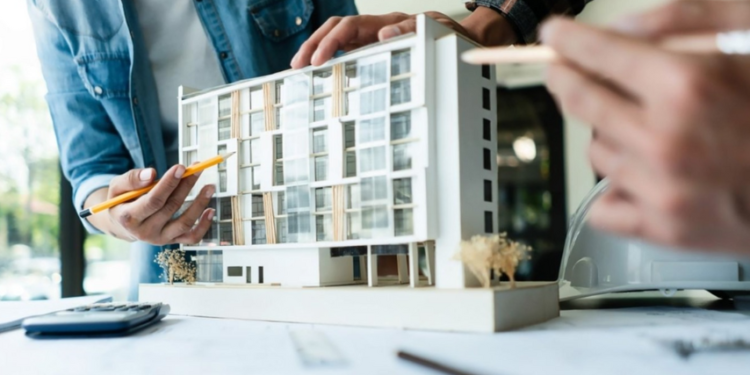Luxury interiors are defined by more than just high-end finishes. They are shaped by how materials interact, contrast, and complement each other. This layering of textures, surfaces, and tones creates a sense of depth and richness in a space.
In Dubai, where the interior design market is filled with premium villas, boutique hotels, and upscale retail, luxury material layering is an essential design language. Model making for Dubai interiors plays a vital role in communicating this complexity. It brings material choices to life in a way that drawings and digital renders alone cannot achieve.
Understanding Material Layering in Luxury Interiors
Material layering refers to the deliberate use of different finishes and textures within a single design composition. It often includes combinations such as marble with brass, velvet against wood, or textured wall coverings beside polished stone. These layers are not just visual. They influence how a space feels. The contrast between cool and warm finishes, smooth and rough surfaces, or matte and glossy tones adds personality to luxury interiors.
In Dubai, this design approach is used widely across residential and commercial projects. Interior designers often mix global design influences with regional tastes. This results in interiors that are visually rich, culturally relevant, and emotionally engaging. However, conveying these material combinations to clients and construction teams requires more than mood boards. That’s where interior-focused model making comes in.
How Model Making Dubai Interiors Represents Material Layering
Model making Dubai allows designers to build scale models that reflect the intended material palette. While full replication of real materials is not always possible at small scales, skilled model makers in Dubai use creative techniques to mimic finishes. This includes applying colored films, textured surfaces, metallic sheets, or printed patterns to represent different materials. These elements are carefully applied to walls, floors, ceilings, furniture, and feature panels in the model.
This helps clients and design teams visualize how different materials will appear when placed next to each other. They can see transitions, overlaps, alignments, and contrasts in physical form. This is especially important for luxury projects where layering defines the space’s identity.
Creating Visual Depth in Design Presentations
One of the key advantages of model making is that it adds three-dimensional depth to design presentations. Luxury interiors often include elements like layered ceiling panels, recessed lighting, inlaid flooring, and decorative wall claddings. These features create visual hierarchy within a space. A scale model shows how these layers physically step forward or recede.
For instance, a living room may include a marble feature wall layered with a wooden lattice and integrated LED backlighting. A physical model helps visualize this composition better than a flat image. It shows how the wood casts a shadow on the marble and how the light diffuses behind it. This added realism enhances design communication and approval.
Helping Clients Understand Texture and Contrast
Luxury clients in Dubai often have strong preferences when it comes to materials. Some may favor natural finishes like stone and timber, while others prefer modern materials such as glass, metal, or leather. Model making helps these clients engage with the design in a tactile and visual way. Even if the textures in the model are simplified, they still offer a clear sense of material contrast and hierarchy.
For example, a client may wish to see how a high-gloss black finish works alongside brushed brass. In the model, this contrast can be simulated, allowing the client to assess whether it feels too sharp, too muted, or perfectly balanced. This process builds confidence in material choices and ensures the final space matches expectations.
Supporting Craftsmanship and Detailing Discussions
Luxury interiors in Dubai often depend on skilled craftsmanship. Many features involve joinery, inlays, metalwork, and hand-applied finishes. Model making allows designers and fabricators to study these details at a smaller scale. The model becomes a reference for understanding how different layers connect or overlap.
Designers can point to specific areas in the model and discuss how a brass edge wraps around a wooden corner or how a leather wall panel meets a marble floor. These insights reduce ambiguity and lead to better coordination with construction teams.
Enhancing Interior Lighting Strategies
Material layering also affects how light behaves in a space. Glossy surfaces reflect light, while matte ones absorb it. Textured materials create shadows, while smooth ones allow light to glide over them. Interior-focused model making helps simulate these interactions.
Many Dubai model making studios include simple lighting systems in their interior models. These small-scale lights help show how real materials will catch and reflect light. This supports lighting designers in placing fixtures more effectively and ensures the final space enhances material beauty through well-directed illumination.
Presenting Mood and Atmosphere
Every luxury interior tells a story. Whether it’s a calm, spa-like atmosphere or a vibrant, hospitality-themed mood, the combination of materials sets the tone. Model making allows this story to unfold in three-dimensional form. It reveals how materials guide movement through the space, how they respond to light, and how they complement furniture and artwork.
Interior models help designers create immersive narratives around the material selection. They can use the model to explain why a dark wood veneer was chosen for intimacy or how a metallic surface adds drama to an entrance. This storytelling approach resonates strongly with high-end clients in Dubai.
Conclusion
Model making Dubai interiors plays a vital role in showcasing luxury material layering. It translates complex design ideas into tangible, understandable forms. It helps clients, designers, and builders see how materials interact before installation begins.
By offering insight into contrast, texture, depth, and craftsmanship, interior model making strengthens the design process. It ensures that the final space not only looks luxurious but also feels cohesive and refined. As Dubai continues to lead in global interior innovation, model making remains an essential bridge between vision and reality.














